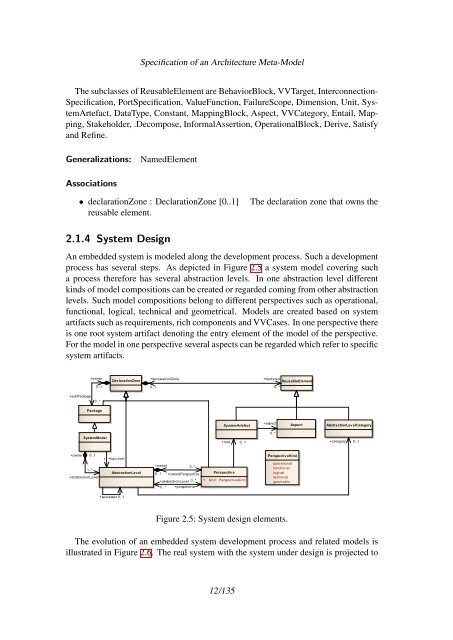Specification of an Architecture Meta-Model - SPES 2020
Specification of an Architecture Meta-Model - SPES 2020
Specification of an Architecture Meta-Model - SPES 2020
Create successful ePaper yourself
Turn your PDF publications into a flip-book with our unique Google optimized e-Paper software.
<strong>Specification</strong> <strong>of</strong> <strong>an</strong> <strong>Architecture</strong> <strong>Meta</strong>-<strong>Model</strong><br />
The subclasses <strong>of</strong> ReusableElement are BehaviorBlock, VVTarget, Interconnection-<br />
<strong>Specification</strong>, Port<strong>Specification</strong>, ValueFunction, FailureScope, Dimension, Unit, SystemArtefact,<br />
DataType, Const<strong>an</strong>t, MappingBlock, Aspect, VVCategory, Entail, Mapping,<br />
Stakeholder, .Decompose, InformalAssertion, OperationalBlock, Derive, Satisfy<br />
<strong>an</strong>d Refine.<br />
Generalizations: NamedElement<br />
Associations<br />
• declarationZone : DeclarationZone [0..1] The declaration zone that owns the<br />
reusable element.<br />
2.1.4 System Design<br />
An embedded system is modeled along the development process. Such a development<br />
process has several steps. As depicted in Figure 2.5 a system model covering such<br />
a process therefore has several abstraction levels. In one abstraction level different<br />
kinds <strong>of</strong> model compositions c<strong>an</strong> be created or regarded coming from other abstraction<br />
levels. Such model compositions belong to different perspectives such as operational,<br />
functional, logical, technical <strong>an</strong>d geometrical. <strong>Model</strong>s are created based on system<br />
artifacts such as requirements, rich components <strong>an</strong>d VVCases. In one perspective there<br />
is one root system artifact denoting the entry element <strong>of</strong> the model <strong>of</strong> the perspective.<br />
For the model in one perspective several aspects c<strong>an</strong> be regarded which refer to specific<br />
system artifacts.<br />
+subPackage<br />
Package<br />
System<strong>Model</strong><br />
+owner 0..1<br />
1..*<br />
+owner<br />
0..1<br />
0..*<br />
+abstractionLevel<br />
DeclarationZone<br />
1 +topLevel<br />
AbstractionLev el<br />
+successor 0..1<br />
+declarationZone<br />
0..1<br />
+owner<br />
0..1<br />
0..*<br />
+ownedPerspective<br />
+abstractionLevel 0..*<br />
0..* +perspective<br />
SystemArtefact<br />
+root 0..1<br />
Perspectiv e<br />
+ kind: PerspectiveKind<br />
+declared<br />
ReusableElement<br />
+aspect<br />
0..*<br />
Aspect<br />
Perspectiv eKind<br />
operational<br />
functional<br />
logical<br />
technical<br />
geometric<br />
Figure 2.5: System design elements.<br />
0..*<br />
AbstractionLev elCategory<br />
+category 0..1<br />
The evolution <strong>of</strong> <strong>an</strong> embedded system development process <strong>an</strong>d related models is<br />
illustrated in Figure 2.6. The real system with the system under design is projected to<br />
12/135
















